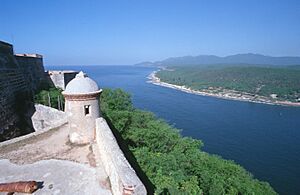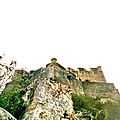Castillo de San Pedro de la Roca facts for kids
Quick facts for kids Castillo de San Pedro de la Roca |
|
|---|---|

Castillo de San Pedro de la Roca
|
|
| Location | Santiago de Cuba, Cuba |
| Built | 1638 |
| Architect | Giovanni Battista Antonelli |
| Official name: San Pedro de la Roca Castle, Santiago de Cuba | |
| Type | Cultural |
| Criteria | iv, v |
| Designated | 1997 (21st session) |
| Reference no. | 841 |
| Region | Latin America and the Caribbean |
The Castillo de San Pedro de la Roca is a famous old fortress in Santiago de Cuba, Cuba. People also call it Castillo del Morro. It sits on the coast, looking over the bay, about 6 miles (10 km) from the city center. In 1997, UNESCO named it a World Heritage Site. This means it's a very important historical place. It's known as one of the best examples of old Spanish military buildings in the Americas.
Contents
History of the San Pedro de la Roca Castle
Planning the Castle's Design
Before the main castle, some smaller defenses were built between 1590 and 1610. These helped protect Santiago de Cuba from attacks. In the early 1600s, a bigger fort was planned. It was designed by Battista Antonelli, a skilled engineer from Italy. He worked for the city's governor, Pedro de la Roca de Borja. The main goal was to defend against pirate attacks.
Antonelli designed the fort to fit the steep hillside. This hill was called the morro, which is where the castle gets its other name. The castle was built on different levels, like terraces. It had four main floors and three large bulwarks for cannons. Supplies arrived by sea and were stored in a huge warehouse. This warehouse was carved right into the rock. Other supplies went up to the top level, where the main citadel was.
Building the castle took a very long time. It started in 1638 and finished in 1700. Antonelli was called back to Cuba in 1598. You can see other forts he designed there, like Fuerte del Cojimar and Torreón de la Chorrera. Some parts of the older defenses were later added to the main castle.
Building and Defending the Fortress
The fear of pirates was real. In 1662, while the castle was still being built, English pirates attacked. They were led by Christopher Myngs. They took over Santiago for two weeks. During their stay, they damaged parts of the castle. They also took the cannons.
After the pirates left, the Spanish government ordered repairs. They also increased the number of soldiers to 300. From 1663 to 1669, engineers like Juan Císcara Ibáñez and Francisco Perez worked on fixing the damage. They also made the castle stronger. They built new platforms for cannons.
The castle proved its strength. In 1678, it stopped an attack by a French group. In 1680, it fought off another attack by 800 men. These men were led by Franquesma, a famous pirate leader.
Repairs After Earthquakes
Between 1675 and 1692, a series of earthquakes damaged the fortress. More repairs were needed. Francisco Pérez led this work from 1693 to 1695. From 1738 to 1740, engineer Antonio de Arredondo made more improvements. He made the main citadel bigger and finished some platforms.
The castle was damaged again by earthquakes between 1757 and 1766. Juan Martín Cermeño and Francisco Calderín made the final changes after these events.
By 1775, the threat of attacks was less. Parts of the castle, called the Rock and the Star, became a prison. They held political prisoners. However, the rest of the castle remained a military base. It was used as a fortress again in 1898. This was when the United States' fleet attacked Santiago de Cuba during the Spanish–American War.
In the 20th century, the fort started to fall apart. But it was restored in the 1960s by Francisco Prat Puig.
Gallery
See also
 In Spanish: Castillo de San Pedro de la Roca para niños
In Spanish: Castillo de San Pedro de la Roca para niños












